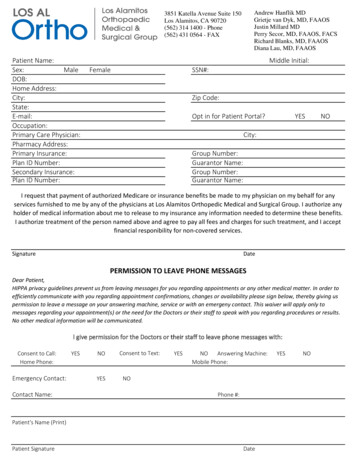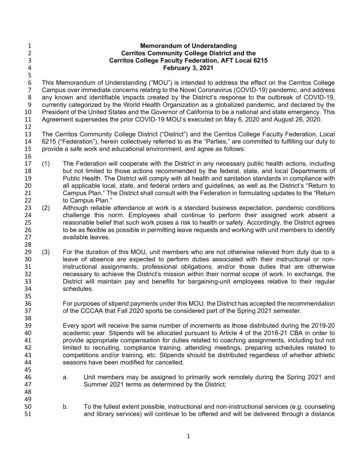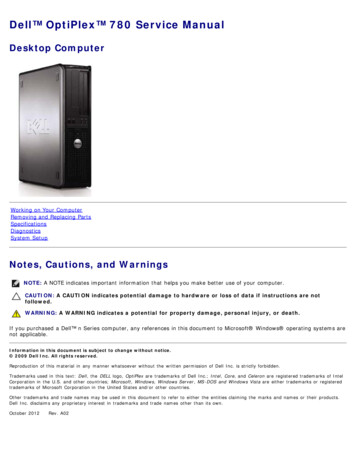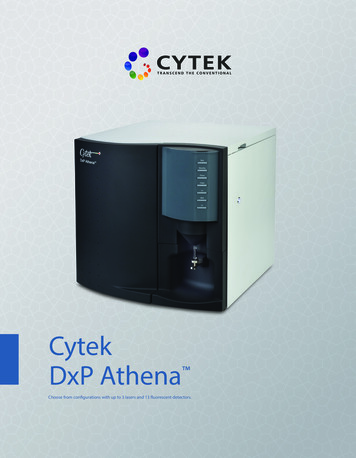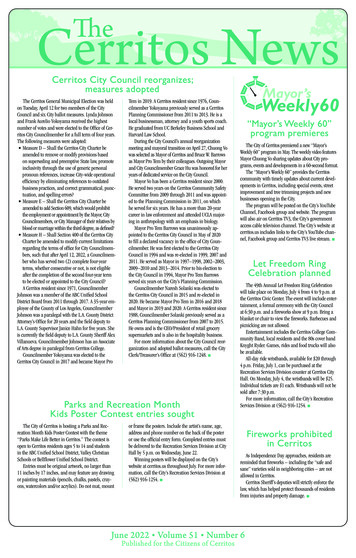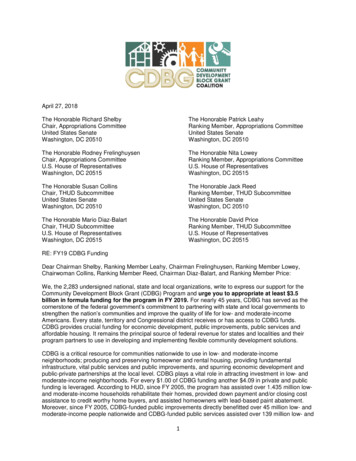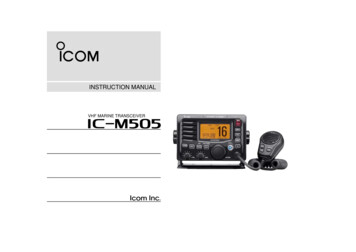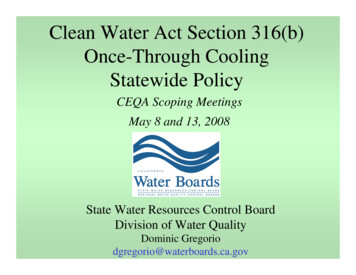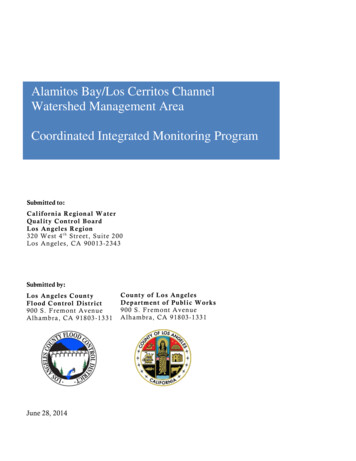
Transcription
Alamitos Bay/Los Cerritos ChannelWatershed Management AreaCoordinated Integrated Monitoring ProgramSubmitted to:California Region al W aterQuality Con tr ol Boar dLos An geles Region320 West 4 t h Street, Suite 200Los Angeles, CA 90013 -2343Submitted by:Los An geles Coun tyFlood Con tr ol Distr ict900 S. Fremont AvenueAlhambra, CA 91803 -1331June 28, 2014Coun ty of Los An gelesDepar tm ent of Public Wor ks900 S. Fremont AvenueAlhambra, CA 91803 -1331
[This page intentionally left blank]
Table of ContentsSection 1.Introduction . 11.1Background . 11.2Objective . 11.3Approach . 11.4AB/LCC Watershed Management Area . 31.4.1 Los Cerritos Channel Freshwater Watershed . 31.4.2 Los Cerritos Channel Estuary Watershed . 41.4.3 Alamitos Bay Watershed . 41.4.4 County Island . 5Section 2.Existing TMDLs and Monitoring Programs in the AB/LCC WMA . 62.1Los Cerritos Channel Metals TMDL . 62.2Dominguez Channel Toxics TMDL . 62.3Colorado Lagoon Toxics TMDL Monitoring Plan . 72.4Beneficial Uses . 8Section 3.3.1Water Quality Priorities . 9Objective . 9Section 4.Receiving Water Monitoring . 124.1Objective . 124.2MS4 Receiving Water Site. 124.3TMDL Receiving Water Sites . 144.3.1 Los Cerritos Channel Metals TMDL . 144.3.2 DC Toxics TMDL . 174.3.3 Colorado Lagoon Toxics TMDL . 19Section 5.Stormwater Outfall Monitoring . 215.1Objective . 215.2Approach . 21Section 6.Non-Stormwater Outfall Monitoring Program. 226.1Objective . 226.2Outfalls Within AB/LCC Group’s Jurisdiction . 226.3Approach . 256.3.1 Inventory Outfalls . 25Alamitos Bay/Los Cerritos ChannelCoordinated Integrated Monitoring ProgramiiiJune 2013
6.3.2 Field Screening of Outfalls . 256.3.3 Determination of Further Assessment . 256.3.4 Prioritization Schedule . 256.3.5 Non-Stormwater Source Identification . 256.3.6 Monitor . 266.3.7 Reassessment . 26Section 7.7.1Overview . 27Section 8.8.1Monitoring Program Overview . 30Overview . 30Section 11.11.1Optional Source Identification: County Island . 29Overview . 29Section 10.10.1Regional Studies . 28Overview . 28Section 9.9.1New/Redevelopment BMP Effectiveness Tracking System . 27Reporting . 32Monitoring Reports . 32Section 12.References . 33Alamitos Bay/Los Cerritos ChannelCoordinated Integrated Monitoring ProgramivJune 2013
List of s Bay/Los Cerritos ChannelBasin Plan AmendmentBest Management PracticeCoordinated Integrated Monitoring ProgramColorado Lagoon TMDL Monitoring PlanDichlorodiphenyltrichloroethaneEnvironmental Protection AgencyGeographic Information SystemHydrologic Response UnitIllicit Connections and Illicit DischargesLos Angeles County Flood Control DistrictLos Angeles Regional Water Quality Control BoardLos Cerritos Channel Watershed GroupLow Impact DevelopmentMunicipal Action LevelMinimum Control MeasureMunicipal Separate Storm Sewer SystemMonitoring and Reporting ProgramNitrogenNational Pollutant Discharge Elimination SystemNon StormwaterPolychlorinated BiphenylsPublic Information and Participation ProgramQuality Assurance/Quality ControlReasonable Assurance AnalysisRegional Monitoring CoalitionReceiving Water LimitationsSouthern California Stormwater Monitoring CoalitionTotal Maximum Daily LoadTotal NitrogenTotal PhosphorusUnited State Environmental Protection AgencyWaste Load AllocationWatershed Management AreaWater Quality Based Effluent LimitationsAlamitos Bay/Los Cerritos ChannelCoordinated Integrated Monitoring ProgramvJune 2013
List of TablesTable 1: Beneficial Uses in AB/LCC WMA . 8Table 2: Water Quality Priorities for the Freshwater Portion of the Los Cerritos Channel . 11Table 3: Category 2: LCC Metals TMDL Wet Weather WLAs . 14Table 4: Category 2: LCC Metals TMDL Dry Weather WLA . 14Table 5: Hydraulic Response Unit Comparison . 17Table 6: AB/LCC Group’s Outfall Description and Photo . 24Table 7: Summary of Nutrient and Toxics TMDL Sampling. . 31Alamitos Bay/Los Cerritos ChannelCoordinated Integrated Monitoring ProgramviJune 2013
List of FiguresFigure 1: Three Subwatersheds within Alamitos Bay/LCC Group Limits . 2Figure 2: Los Cerritos Channel Freshwater/Estuary Transition . 3Figure 3: Los Cerritos Channel Estuary. 4Figure 4: Colorado Lagoon . 5Figure 5: Unincorporated County Island . 5Figure 6: Los Cerritos Channel Watershed Group . 10Figure 7: Stearns Street Mass Emission Station . 12Figure 8: Stearns Street Mass Emission Station Location . 13Figure 9: Palo Verde Drain: LCC Metals TMDL Receiving Water Site . 15Figure 10: Palo Verde Drain: LCC Metals TMDL Receiving Water Site . 16Figure 11: DC and Greater LA/LB Harbors Toxics TMDL Receiving Water Site . 18Figure 12: Colorado Lagoon Metals TMDL Receiving Water Sites . 20Figure 13: MS4 Outfalls in the AB/LCC WMA Jurisdiction . 23Figure 14: County Island Specific Monitoring Approach . 29Figure 15: AB/LCC Group’s Monitoring Locations . 30Alamitos Bay/Los Cerritos ChannelCoordinated Integrated Monitoring ProgramviiJune 2013
Section 1.1.1IntroductionBACKGROUNDThe Alamitos Bay/Los Cerritos Channel (AB/LCC) Coordinated Integrated Monitoring Program(CIMP) is a collaborative effort between the County of Los Angeles (County) and the LosAngeles County Flood Control District (LACFCD). The geographic scope of this CIMPincludes the County’s jurisdiction and certain LACFCD infrastructure within the 37.5 squaremile AB/LCC Watershed Management Area (WMA). In particular the following areas arecovered in this CIMP: 95-acre County Island LACFCD’s infrastructure within the County Island, the Los Cerritos Channel Estuarywatershed and the Alamitos Bay watershed.As shown in Figure 1, the County and the LACFCD, collectively the Alamitos Bay/Los CerritosChannel Group (AB/LCC Group), make up a very small portion of the overall WMA. TheAB/LCC CIMP is being submitted to meet the Monitoring and Reporting Program requirementsoutlined in Attachment E of the National Pollutant Discharge Elimination System (NPDES)Municipal Separate Storm Sewer System (MS4) Permit No. R4-2012-0178 (Permit). The Permitwas adopted on November 8, 2012 and became effective December 28, 2012.1.2OBJECTIVESection II of Attachment E of the Permit states the primary objectives of the Monitoring Programare to: Assess the chemical, physical, and biological impacts of discharges from the MS4 onreceiving waters. Assess compliance with receiving water limitations and water quality-based effluentlimitations (WQBELs) established to implement Total Maximum Daily Load (TMDL)wet weather and dry weather wasteload allocations (WLAs). Characterize pollutant loads in MS4 discharges. Identify sources of pollutants in MS4 discharges. Measure and improve the effectiveness of pollutant controls implemented under thePermit1.3APPROACHThis CIMP utilizes existing monitoring efforts in the AB/LCC WMA and proposes additionalefforts to meet the objectives of the Permit. Additionally, this CIMP maximizes coordinationopportunities with other CIMPs in the AB/LCC WMA.Alamitos Bay/Los Cerritos ChannelCoordinated Integrated Monitoring Program1June 2013
Figure 1: Three Subwatersheds within Alamitos Bay/LCC Group LimitsAlamitos Bay/Los Cerritos ChannelCoordinated Integrated Monitoring Program2June 2013
1.4AB/LCC WATERSHED MANAGEMENT AREAThe Alamitos Bay/Los Cerritos Channel Watershed Management Area (AB/LCC WMA) islocated in southern Los Angeles County and has a drainage area of approximately 37.5 squaremiles. The AB/LCC WMA encompasses the Los Cerritos Channel freshwater watershed, theLos Cerritos Channel estuary watershed and the Alamitos Bay watershed. These watersheds andthe areas covered in this CIMP are shown in Figure 1. It should be noted that within theAB/LCC WMA there are multiple existing monitoring programs as well as parallel CIMPefforts. The AB/LCC Group has made significant efforts to coordinate this CIMP with otherprograms in the AB/LCC WMA.Within the AB/LCC WMA, there is a 95 acre unincorporated area of the County of Los Angeles(County Island). Additionally, the LACFCD operates and maintains storm drains and otherappurtenant drainage infrastructure within the AB/LCC WMA. This drainage infrastructureserves as a conveyance for waters within the watershed and the LACFCD has no jurisdictionover the land uses within the watershed that generate the pollutants of concern. Furtherdescription of the LACFCD and its functions is provided in Appendix A.1.4.1 Los Cerritos Channel Freshwater WatershedThe Los Cerritos Channel freshwater watershed has a total drainage area of approximately 27.7square miles. The Los Cerritos Channel freshwater watershed drains to a concrete lined channelwhich is operated and maintained by the LACFCD. Generally, the downstream limit of thefreshwater watershed is considered to be just south of Atherton Street as shown in Figure 2. Itshould be noted that high tides can push tidal surges upstream of Atherton Street. The drainagearea of the freshwater watershed is within the jurisdiction of the County, CALTRANS andseveral cities including Bellflower, Cerritos, Downey, Lakewood, Long Beach, Paramount andSignal Hill.Figure 2: Los Cerritos Channel Freshwater/Estuary TransitionAlamitos Bay/Los Cerritos ChannelCoordinated Integrated Monitoring Program3June 2014
1.4.2 Los Cerritos Channel Estuary WatershedThe Los Cerritos Channel Estuary (Estuary) is approximately 1.5 miles long and extends fromjust south of Atherton St. to the Alamitos Bay. The Estuary is under tidal influence (Figure 3)and is characterized by a trapezoidal geometry with rip-rap sides and a natural bottom. Thedrainage area directly tributary to the Estuary is approximately 4.1 square miles. The Estuary isunder the jurisdiction of the LACFCD while the drainage area consists entirely of the City ofLong Beach and CALTRANS.Figure 3: Los Cerritos Channel Estuary1.4.3 Alamitos Bay WatershedThe Alamitos Bay Watershed has a total drainage area of approximately 5.7 square miles. Thisarea includes the Colorado Lagoon which is situated at the northwestern end of Alamitos Bay.The Colorado Lagoon subwatershed is approximately 1.8 square miles. Alamitos Bay andColorado Lagoon are hydraulically connected via an underground culvert which connectsColorado Lagoon to the Marine Stadium portion of Alamitos Bay. The Alamitos Baywatershed’s drainage area is completely within the jurisdiction of the City of Long Beach andCALTRANS.Alamitos Bay/Los Cerritos ChannelCoordinated Integrated Monitoring Program4June 2014
Figure 4: Colorado Lagoon1.4.4 County IslandWithin the AB/LCC WMA is the County Island is known as the “North Long Beach Island”.The County Island is landlocked by the City of Long Beach (Figure 5). The County Island is 95acres (0.15 square miles) and is predominantly High-Density Single Family Residential LandUse.PaloVerdeDrainFigure 5: Unincorporated County IslandAlamitos Bay/Los Cerritos ChannelCoordinated Integrated Monitoring Program5June 2014
Section 2. Existing TMDLs and MonitoringPrograms in the AB/LCC WMAWithin the AB/LCC WMA, there are 3 existing TMDLs which each require Monitoring andReporting Programs.2.1LOS CERRITOS CHANNEL METALS TMDLThe Total Maximum Daily Load for Metals in Los Cerritos Channel (LCC Metals TMDL) wasapproved by the United States Environmental Protection Agency (USEPA) on March 17, 2010.The Metals TMDL was developed to address beneficial use impairments due to Copper, Zincand Lead in the freshwater portion of the Los Cerritos Channel. The freshwater portion of LosCerritos Channel has the existing beneficial use of Wildlife Habitat (WILD), the potentialbeneficial uses of Municipal and Domestic Supply (MUN), Water Contact Recreation (REC1)and the intermittent beneficial uses of Warm Freshwater Habitat (WARM), and Non-contactWater Recreation (REC2).On June 6, 2013, the Los Angeles Regional Water Quality Control Board (LARWQCB) adopteda resolution which includes an Implementation Schedule for the LCC Metals TMDL. TheImplementation Schedule states that MS4 permittees shall submit a coordinated monitoring plan,which includes compliance and receiving water monitoring by September 30, 2015. Amonitoring plan submitted pursuant to the NPDES Permit may be used by permittees to satisfythe TMDL monitoring requirements. The AB/LCC Group is submitting this CIMP to satisfy thecoordinated monitoring plan requirements of the LCC Metals TMDL.2.2DOMINGUEZ CHANNEL TOXICS TMDLThe Total Maximum Daily Load for Toxic Pollutants in Dominguez Channel and Greater LosAngeles and Long Beach Harbor Waters (DC Toxics TMDL) was adopted by the LARWQCBon May 5, 2011. The DC Toxics TMDL became effective on March 23, 2012. The goal of theTMDL is to protect and restore fish tissue, water and sediment quality in Dominguez Channeland Greater Los Angeles and Long Beach Harbor waters by remediating contaminated sedimentand controlling the sediment loading and accumulation of contaminated sediment in the Harbors.The County and the LACFCD are both listed as responsible parties for the Greater Harborswaterbody. The DC Toxics TMDL states that “The Greater Los Angeles and Long BeachHarbors responsible parties are each individually responsible for conducting water, sediment,and fish tissue monitoring. However, they are encouraged to collaborate or coordinate theirefforts to avoid duplication and reduce associated costs” (DC Toxics TMDL, Basin PlanAmendment pg. 27). Accordingly, both County and LACFCD are participating in the GreaterHarbors Regional Monitoring Coalition (RMC). More information can be found in Section4.3.2.As recognized by the footnote in Attachment K-7 of the Permit, the County and the LACFCDhave entered into an Amended Consent Decree with the United States and the State of California,including the LARWQCB, pursuant to which the LARWQCB has released the County and theLACFCD from responsibility for Toxic pollutants in the Dominguez Channel and the GreaterHarbors. Accordingly, no inference should be drawn from the submission of this CIMP or fromany action or implementation taken pursuant to it that the County or the LACFCD is obligated toAlamitos Bay/Los Cerritos ChannelCoordinated Integrated Monitoring Program6June 2014
implement the DC Toxics TMDL, including this CIMP or any of the DC Toxics TMDL’s otherobligations or plans, or that the County or the LACFCD have waived any rights under theAmended Consent Decree.2.3COLORADO LAGOON TOXICS TMDL MONITORING PLANThe Colorado Lagoon Organochlorine Pesticides, PCBs, Sediment Toxicity, PAHs, and MetalsTMDL (Colorado Lagoon Toxics TMDL) was adopted by the LARWQCB on October 1, 2009.The Colorado Lagoon Toxics TMDL was developed to restore fish tissue and sediment inColorado Lagoon by controlling the contaminated sediment loading and accumulation ofcontaminated sediment in the lagoon. The Colorado Lagoon has beneficial uses of Commercialand Sport Fishing (COMM), Wildlife Habitat (WILD), Shellfish Harvesting (SHELL), WaterContact Recreation (REC1), Non-Contact water recreation (REC2) and the potential use ofWarm Freshwater Habitat (WARM).On December 17, 2012 the LACFCD along the City of Long Beach and CALTRANS submittedthe Final Colorado Lagoon TMDL Monitoring Plan (CLTMP). More information on thismonitoring program can be found in Section 4.3.3.Alamitos Bay/Los Cerritos ChannelCoordinated Integrated Monitoring Program7June 2014
2.4BENEFICIAL USESBeneficial uses for waterbodies in the AB/LCC WMA are shown in Table 1.Table 1: Beneficial Uses in AB/LCC WMAWater BodyLos CerritosChannelFreshwaterSegmentBeneficial UsesWildlife Habitat (WILD)ExistingPotentialMunicipal and Domestic Supply (MUN)Water Contact Recreation (REC1)IntermittentWarm Freshwater Habitat (WARM)Non-contact Water Recreation (REC2)Los CerritosChannel EstuaryColorado LagoonIndustrial Service Supply (IND)Navigation (NAV)Commercial and Sport Fishing (COMM)Estuarine Habitat (EST)Marine Habitat (MAR)Wildlife Habitat (WILD)Rare, Threatened, or Endangered Species(RARE)Migration of Aquatic Organisms (MIGR)Spawning, Reproduction, and/or EarlyDevelopment (SPWN)Shellfish Harvesting (SHELL)Water Contact Recreation (REC1)Non-Contact water recreation (REC2)Commercial and Sport Fishing (COMM)Wildlife Habitat (WILD)Shellfish Harvesting (SHELL)Water Contact Recreation (REC1)Non-Contact water recreation (REC2)Warm Freshwater Habitat (WARM)ExistingExistingPotentialMarine StadiumAlamitos BayAlamitos Bay/Los Cerritos ChannelCoordinated Integrated Monitoring ProgramExistingWater Contact Recreation (REC1)Non-Contact water recreation (REC2)ExistingWater Contact Recreation (REC1)Non-Contact water recreation (REC2)8June 2014
Section 3.3.1Water Quality PrioritiesOBJECTIVEPer Section V1.C.5 of the Permit, three categories of pollutants are identified to aid in theevaluation of existing water quality conditions. These classifications consist of: Category 1 (Highest Priority): Water body-pollutant combinations for which waterquality-based effluent limitations and/or receiving water limitations are established inPart VI.E and Attachments L through R of this Order.Category 2 (High Priority): Pollutants for which data indicate water quality impairment inthe receiving water according to the State’s Water Quality Control Policy for DevelopingCalifornia’s Clean Water Act Section 303(d) List (State Listing Policy) and for whichMS4 discharges may be causing or contributing to the impairment.Category 3 (Medium Priority): Pollutants for which there are insufficient data to indicatewater quality impairment in the receiving water according to the State’s Listing Policy,but which exceed applicable receiving water limitations contained in this Order and forwhich MS4 discharges may be causing or contributing to the exceedance”The AB/LCC group is coordinating portions of its monitoring efforts, where feasible with theLos Cerritos Channel Watershed Group (LCCWG). The LCCWG consists of the cities ofBellflower, Cerritos, Downey, Lakewood, Long Beach, Paramount and Signal Hill.Additionally, the LCCWG contains the LACFCD’s infrastructure within these cities’jurisdiction. See Figure 6 for the geographical boundaries of the LCCWG.Alamitos Bay/Los Cerritos ChannelCoordinated Integrated Monitoring Program9June 2014
Figure 6: Los Cerritos Channel Watershed GroupFor consistency with the LCCWG, the AB/LCC Group has identified Low Priority Pollutants.These pollutants fall below the requirements of Category 3, however there has been at least oneexceedance of these pollutants within the past 10 years. Consistent with the requirements of thePermit, existing TMDLs and the 303(d) list were used to determine Category 1 and 2 pollutants.Historic monitoring data collected from the Stearns Street Station (Figure 7 and Figure 8) wasused to determine Category 3 and low priority pollutants. Table 2 lists the pollutants of concernfor the freshwater portion of the Los Cerritos Channel. A detailed analysis of these pollutants ofconcern and their priority category can be found in the AB/LCC WMA WMP.Alamitos Bay/Los Cerritos ChannelCoordinated Integrated Monitoring Program10June 2014
Table 2: Water Quality Priorities for the Freshwater Portion of the Los Cerritos ChannelCategory 1 (Highest Priority)WaterbodyPollutantTMDLCategory 2 (High Priority)PollutantsCategory 3 (MediumPriority) PollutantsLow PriorityPollutantsAmmoniaMBASCadmium (wet)Bis(2ethylhexyl) phthalate(DEHP)EnterococcusChlorpyrifos (wet)Copper (wet and dry) LCC MetalsLCC Metals/DCToxicsLCC Metals/DCZincToxicsLeadLos CerritosChannelChlordane (Sediment)DDT (fish tissue) DC ToxicsColiform BacteriaPCBs (fish tissue) DC ToxicsTrashChlordane (fishDC Toxicstissue)Chromium (wet)Diazinon (wetand dry)Dissolved Silver(wet)pHPAHs (sediment) DC ToxicsToxicity (sediment) DC ToxicsAlamitos Bay/Los Cerritos ChannelCoordinated Integrated Monitoring Program11June 2014
Section 4.Receiving Water MonitoringThis CIMP utilizes existing monitoring efforts in the AB/LCC Watershed Management Area(WMA) and proposes additional efforts to meet the objectives of the Permit. The AB/LCCGroup is providing a representative monitoring program which should characterize its dischargeinto the affected receiving waters.4.1OBJECTIVEPer Section II.E.1, Attachment E. of the MS4 Permit, the objective of receiving water monitoringincludes: Determine whether the receiving water limitations are being achieved,Assess trends in pollutant concentrations over time, or during specified conditions,Determine whether the designated beneficial uses are fully supported as determined bywater chemistry, as well as aquatic toxicity and bioassessment monitoring.This CIMP distinguishes two types of receiving water monitoring, MS4 Receiving Water Sitesand TMDL Receiving Water Sites (TMDL Sites).4.2MS4 RECEIVING WATER SITEThe AB/LCC Group intends to use the existing mass emission station at the Stearns Streetcrossing of Los Cerritos Channel as its MS4 Receiving Water Site. The City of Long Beach hasmaintained this mass emission station since 2000. Upon implementation of the LCCWG and theAB/LCC Group’s CIMPs, the City of Long Beach will coordinate with other agencies for theoperation and maintenance of the Stearns Street Site.Figure 7: Stearns Street Mass Emission StationAlamitos Bay/Los Cerritos ChannelCoordinated Integrated Monitoring Program12June 2014
The Stearns Street site is an ideal location as it assessess the overall health of the Los CerrtiosChannel freshwater watershed. Additionally, since this is an existing site, implementation ofmonitoring at this site is expected to begin once CIMPs are approved by the LARWQCB.Figure 8: Stearns Street Mass Emission Station LocationDetails on constituents, methods and frequency of sampling to be conducted at the Stearns Streetsite can be found in the Coordinated Integrated Monitoring Plan for the Los Cerritos ChannelWatershed Monitoring Group.Alamitos Bay/Los Cerritos ChannelCoordinated Integrated Monitoring Program13June 2014
4.3TMDL RECEIVING WATER SITESThere are three existing TMDLs in the AB/LCC WMA for which receiving water monitoring isrequired. The AB/LCC Group will utilize existing monitoring programs and coordinate withparallel CIMP efforts where feasible. The AB/LCC WMA Group may propose new monitoringlocations based on results of the receiving water monitoring program through an adaptiveprocess. The adaptive process is outlined in Figure 14.4.3.1 Los Cerritos Channel Metals TMDLThe LCC Metals TMDL provides WLAs for both wet and dry weather expressed asflow/volumes multiplied by applicable numeric concentration targets and daily pollutant loadingthresholds, respectively. Table 3 and Table 4 summarize those WLAs. It is important to notethat the LCC Metals TMDL is only applicable to the Los Cerritos Channel freshwater watershed(Figure 1).Table 3: Category 2: LCC Metals TMDL Wet Weather WLAsConstituentCopperWLA Daily Maximum (g/day)4.709 x 10-6 x daily storm volume (L)Lead26.852 x 10-6 x daily storm volume (L)Zinc46.027 x 10-6 x daily storm volume (L)Table 4: Category 2: LCC Metals TMDL Dry Weather WLAConstituentCopperWLA Daily Maximum (g/day)67.2The AB/LCC Group will collaborate its monitoring efforts with the LCCWG to determine theimpact of Project 9 Unit 2 Line E (Palo Verde Drain) on the Los Cerritos Channel. Together, theAB/LCC Group and the LCCWG will to monitor at the mouth of the Palo Verde Drain, upstreamof any backwater effects from the Los Cerritos Channel. The discharge at this site also includesrunoff from Cities of Cerritos, Lakewood and Long Beach. Accordingly, monitoring results atthis location will be a representative of the cumulative contribution from all of thesejurisdictions. A photo and the location of this site are shown in Figures 9 and 10, respectively.Details on constituents, methods and frequency of sampling can be found in the CoordinatedIntegrated Monitoring Plan for the Los Cerritos Channel Watershed Monitoring Group.Alamitos Bay/Los Cerritos ChannelCoordinated Integrated Monitoring Program14June 2014
Figure 9: Palo Verde Drain: LCC Metals TMDL Receiving Water SiteFigure 9 shows the channel configuration looking upstream towards Spring Street. At thislocation Palo Verde Drain is a 24 foot by 8 foot rectangular concrete storm drain built in theearly 1960s. The storm drain was constructed and is maintained by the LACFCD.Alamitos Bay/Los C
Alamitos Bay/Los Cerritos Channel 3 June 2014 Coordinated Integrated Monitoring Program 1.4 AB/LCC WATERSHED MANAGEMENT AREA The Alamitos Bay/Los Cerritos Channel Watershed Management Area (AB/LCC WMA) is located in southern Los Angeles County and has a drainage area of approximately 37.5 square miles.
